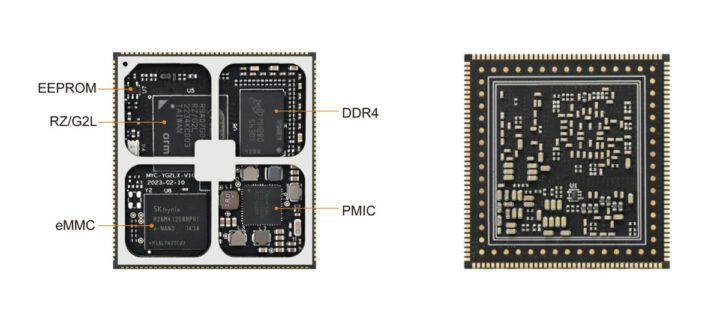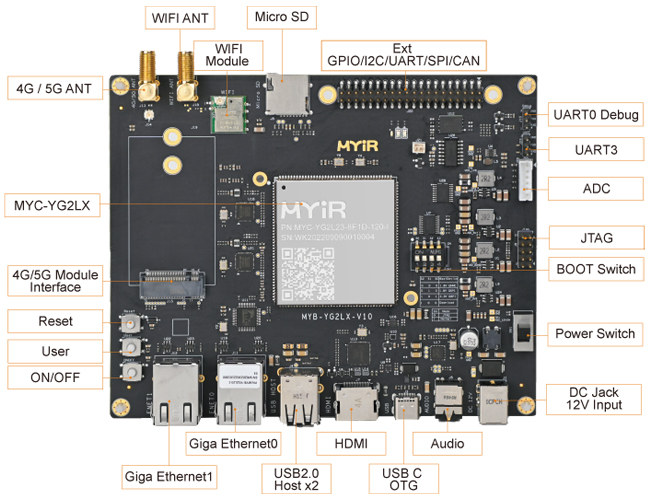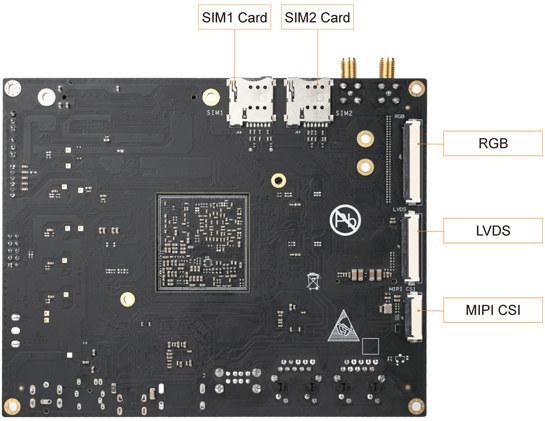MYIR MYC-YG2LX is Renesas RZ/G2L CPU module with up to 4GB DDR4, 32GB eMMC flash, and various I/Os such as gigabit Ethernet, USB 2.0, camera and display interfaces accessible through 222 castellated holes, and designed for advanced HMI, IoT edge gateways, and other embedded devices with video capabilities.
As a reminder, the Renesas RZ/G2L microprocessor comes with up to two Arm Cortex-A55 cores clocked at 1.2 GHz, one 200 MHz Cortex-M33 real-time core, a Mali-G31 GPU for 3D graphics interfaces, and a VPU capable of H.264 encoding/decoding. The company also offers the MYD-YG2LX development board based on the 45x43mm MYC-YG2LX CPU module with easy access to its interfaces.
MYIR MYC-YG2LX Renesas RZ/G2L CPU module
MYC-YG2LX module specifications:
- SoC – Renesas RZ/G2L (R9A07G044L23GBG) dual-core Cortex-A55 processor with Cortex-M33 core @ 200 Mhz, Arm Mali-G31 GPU, H.264 hardware video decoding/encoding
- System Memory – 1 or 2GB DDR4 (option for up to 4GB)
- Storage
- 8GB eMMC flash (option for 4GB, 16GB, or 32GB)
- 32KB EEPROM
- 222-pin 1.0mm pitch stamp hole expansion interface with
- Display – 1x MIPI DSI, 1x RGB
- Camera – 1x MIPI CSI, 1x parallel CSI
- Audio – 4x SSI (Serial Sound Interface), 1x SRC (Sampling Rate Converter)
- Ethernet – 2x RGMII
- USB – 2x USB 2.0
- Serial – 2x SCI (Serial Communication Interface), 2x SCIF (Serial Communication Interface with FIFO), 2x CAN bus interfaces
- Low speed I/Os – 4x I2C, 3x SPI, up to 118x GPIOs
- Analog – 8x ADC
- Power Supply
- 5V/1A input
- Renesas RAA215300 PMIC
- Temperature Range – -40 to 85°C (industrial grade)
- Dimensions – 45mm x 43mm (10-layer PCB)
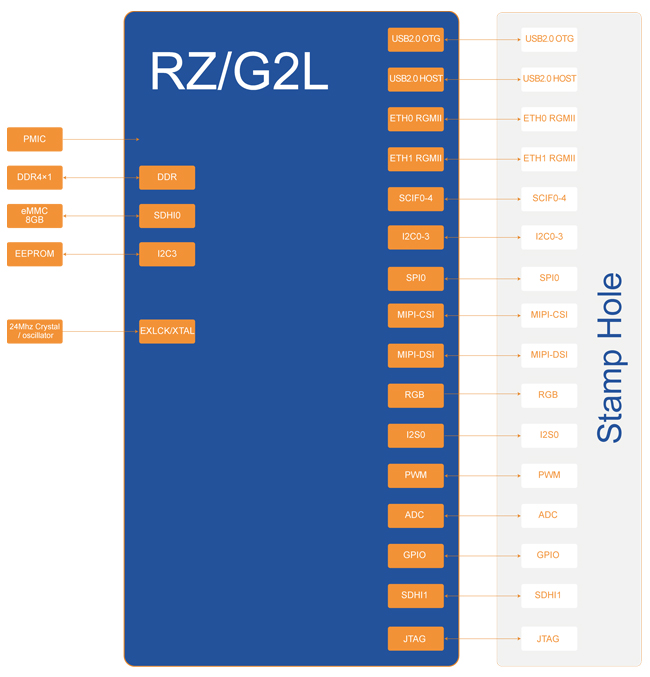
MYiR Tech provides a Linux BSP based on the 5.10.83 kernel with OS images, driver source code, demo applications (charging pile application, PLC controller, engineering machinery scene), and a toolchain.
MYD-YG2LX development board
There’s also a development board for evaluation and to help with early software development.
MYD-YG2LX development board specifications:
- SoM – MYC-YG2LX module as described above
- Storage – MicroSD card slot
- Display interfaces
- HDMI connector
- 40-pin FPC RGB Display interface compatible with MYiR’s 7-inch MY-LCD70TP-C LCD module with a capacitive touchscreen
- 30-pin FPC LVDS Display interface compatible with the MY-LVDS070C 7-inch LCD module with a capacitive touchscreen
- Camera interface – 24-pin FPC connector for MIPI-CSI interface supporting the company’s MY-CAM003M camera module
- Audio – 3.5mm audio jack
- Connectivity
- 2x Gigabit Ethernet RJ45 ports
- Optional USB WiFi module
- Optional 4G/5G LTE module connected to M.2 socket (USB) + 2x SIM card slots
- 2x SMA antenna connectors (one for WiFi and one for 4G/5G)
- USB – 2x USB 2.0 Host ports, 1x USB 2.0 OTG Type-C port
- Serial – 3x RS232 via headers, debug serial port (TTL)
- Expansion – 40-pin Raspberry Pi-compatible GPIO header with GPIO, TWI, UART, etc.. and compatible with the MY-WIREDCOM RPI Module with RS485, RS232, and CAN bus functions
- Misc – Power Switch, 3x buttons (Reset, Power, User)
- Power Supply – 12V/2A power jack
- Dimensions – 150 x 120mm (6-layer PCB)
- Temperature Range – -40 to 85°Cl with wifi module: -20 to 70°C
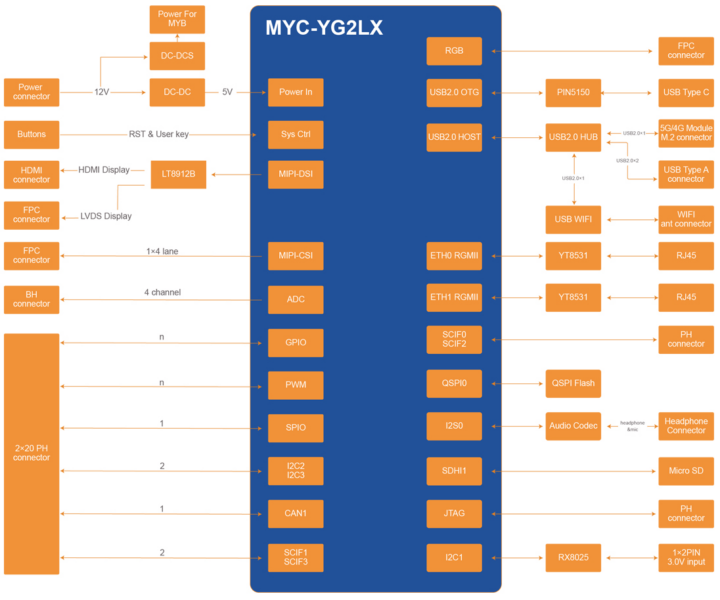
Availability and pricing
The MYC-YG2LX module is available now for $32.80 for the MYC-YG2L23-8E1D-120-I with 1GB RAM, and $35.80 for the MYC-YG2L23-8E2D-120-I with 2GB RAM. The corresponding development kits are sold for $89 and $99, and all items can be purchased online directly via the product page along with optional accessories such as RGB and LVDS displays, the camera, and the MY-WIREDCOM add-on board.
The MYC-YG2LX is far from being the only Renesas RZ/G2L system-on-module, and there are plenty of alternatives such as MistySOM system-on-module, SolidRun RZ/G2LC SOM, Forlinx FET-G2LD-C CPU module, Geniatech SOM-G2L-OSM OSM Size-L module, and others.

Jean-Luc started CNX Software in 2010 as a part-time endeavor, before quitting his job as a software engineering manager, and starting to write daily news, and reviews full time later in 2011.
Support CNX Software! Donate via cryptocurrencies, become a Patron on Patreon, or purchase goods on Amazon or Aliexpress


